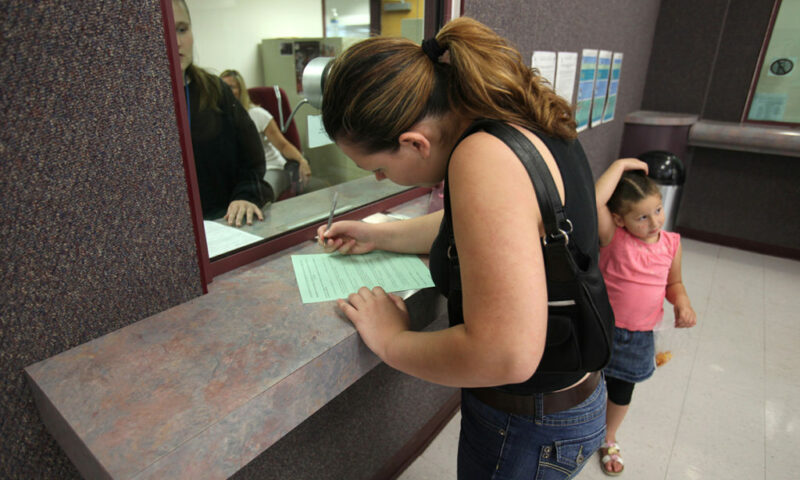

Russell Vought has long proposed deep cuts to social programs like Head Start and SNAP that benefit lower-income people, who were key to Trump’s election in both red and swing states.


Ending the pandemic emergency increases burdens for people with long COVID.


A year after the state crafted the first ever food assistance program for undocumented immigrants, the 2023 budget puts it on hold.


The Trump administration’s proposed food stamp cuts could have a cascading effect on California public schools.


Co-published by The American Prospect
New proposed restrictions mean that immigrants are more liable to be turned away at points of entry, or have their applications to extend their stays in the country be denied.


Charles Gladden has held his current job for eight years. The 63 year old sweeps floors, cleans dishes and mops bathrooms. His take-home pay is about $360 a week and he is currently homeless, moving between shelters and occasionally a Metro stop next to the White House.
Bertrand Olotara is a college graduate and a single father. After being laid off, he now earns $12 an hour as a cook and has a second job which often means he works up to 70 hours a week. Despite these two jobs, he is eligible for food stamps that help him feed his family.
These stories of America’s working poor aren’t anything new, but you may be surprised to learn where they work: the United States Senate. When the Senate privatized food service in their cafeterias and dining rooms, formerly living-wage jobs were converted into poverty-level positions through for-profit contractors like Restaurant Associates and Compass Group.


Twice a year Sacramento goes into a frenzy analyzing the state budget. First, in January, the Governor releases his proposed budget, then the “May Revise” appears as the Governor adjusts projections and heeds advice from Senators and Assembly members. The budget, however, is more than a long economic document. It becomes part of the Governor’s legacy, it’s a statement of his priorities, how he will want to be remembered and what he believes will be best for Californians.
Governor Jerry Brown is shaping a legacy based on fiscal responsibility. He wants to be remembered as the Governor who solved the debt crisis and bequeathed fiscal stability to California. Unlike his predecessor, Governor Brown has invested in education, by creating a solvent K-12 system and reinvesting, albeit modestly, in public higher education. However, he is missing some crucial elements that will undermine this success: namely, an investment in low-income families. The Governor forgot that it is working families who most need fiscal solvency.
» Read more about: Working Families Need a Better May Revise »


The U.S. Census Bureau released figures [September 17] revealing 46.5 million people were living at or below the poverty line — a near-record in the last two decades.
Two days later, the U.S. House of Representatives voted 217-210 to cut food stamps, thinning the rolls by four million people next year and millions more after that. It was a dramatic juxtaposition, made all the more striking because of the heated rhetoric. No Democrat supported the cuts.
Why cut this program now?
Equal Voice News took a look at the arguments, dug up key food stamp facts and found plenty to chew on:
1. Supporters of the cuts say the program, which has been around since the Great Depression, has grown out of control.
True, the program has grown exponentially, from serving 28 million people in 2008 to 47 million last year.
» Read more about: Why Food Stamps Are a Safety Net, Not a “Hammock” »


Even as the new documentary A Place at the Table highlights in heart-wrenching fashion the plight of 16 million U.S. children who don’t know where their next meal is coming from, some want to end a safety net that for decades has stood between some kids and a slow death from malnutrition – the school meal program. Think starvation can’t happen here, in one of the richest countries on earth? Think again. Not only could U.S. children starve without school meals, but not all that long ago, they did.
Terence Jeffrey, editor in chief of CNSnews.com, argues in an article entitled “Sixty-four Percent of Schoolchildren Fed on Federal Subsidies” that the federal school lunch program is “a weapon liberals employ in their war against the family.” This bizarre idea is based on data he presents which allegedly show a correlation between the increasing number of children eating government subsidized school meals since 1969,
» Read more about: Reporting on Hunger in Schools: Let Them Eat “Balance” »


In 15 days, food stamp benefits will be cut by some 20 percent, thanks to Republicans in Congress who tossed this mean-spirited gem into one of GOP’s hostage bills that President Obama was forced to sign because a veto would result in the government shutting down, or the US reneging on its bills, or something equally destructive.
On October 1, millions will see their benefits stripped away or cut greatly.
Most unemployed people will get cut off. Many working poor, who rely on food stamps to make ends meet, will go hungry. So, too, will countless military families – a separate disgrace in and of itself. Far too many homeless families and individuals will find their chair at the dinner table yanked away just as they are sitting down to eat, a sight gag that hasn’t been funny since it was pulled on Fatty Arbuckle in some of his movies back in the Twenties.
» Read more about: Food Stamp Cuts on the Line in Congress »